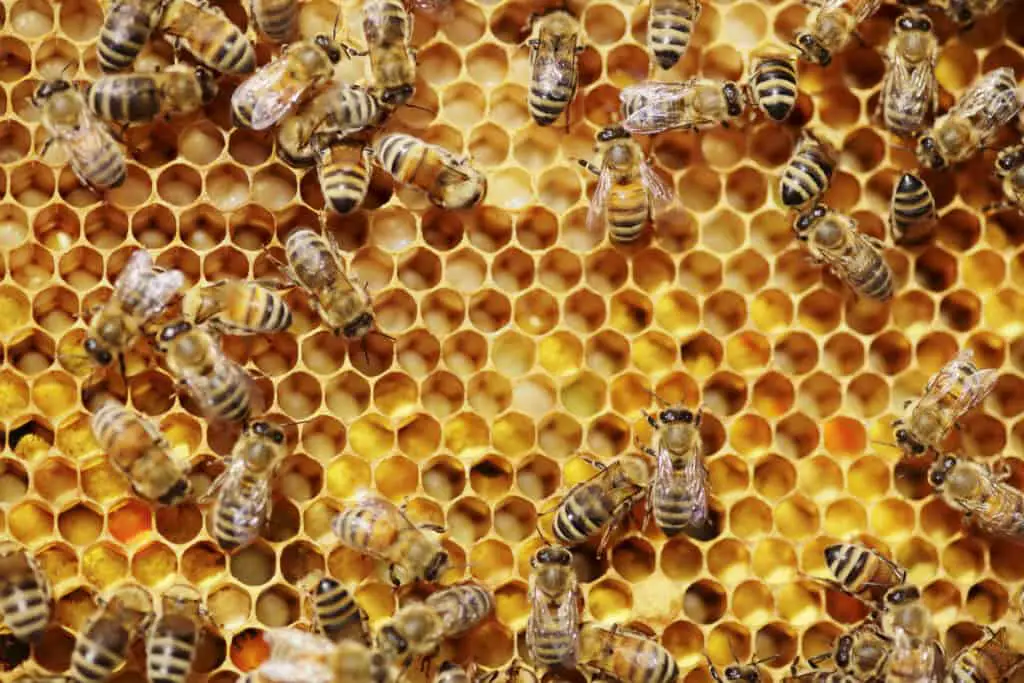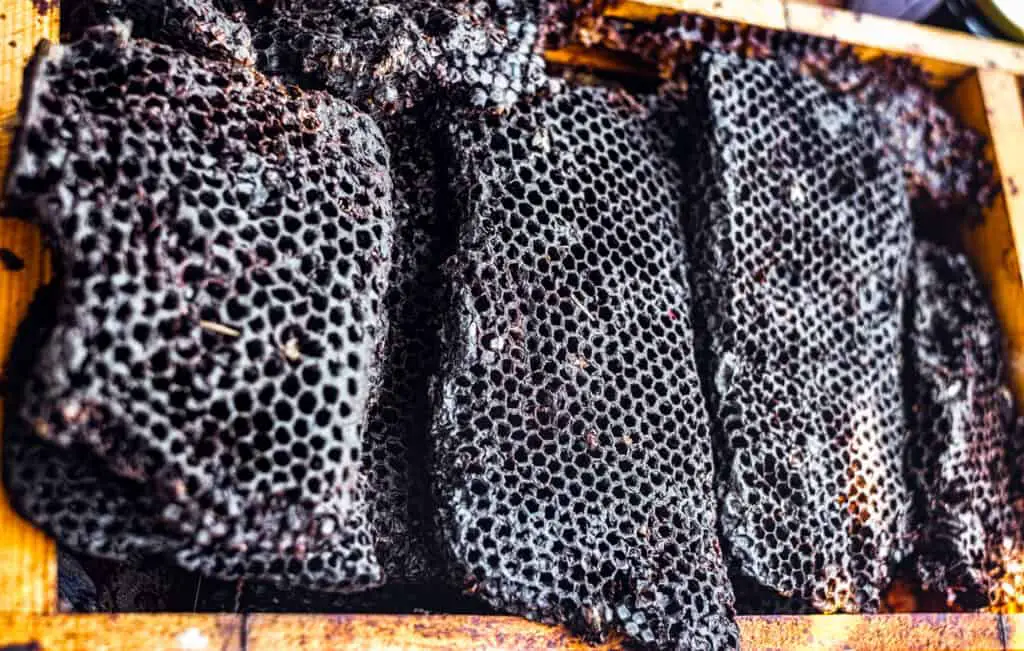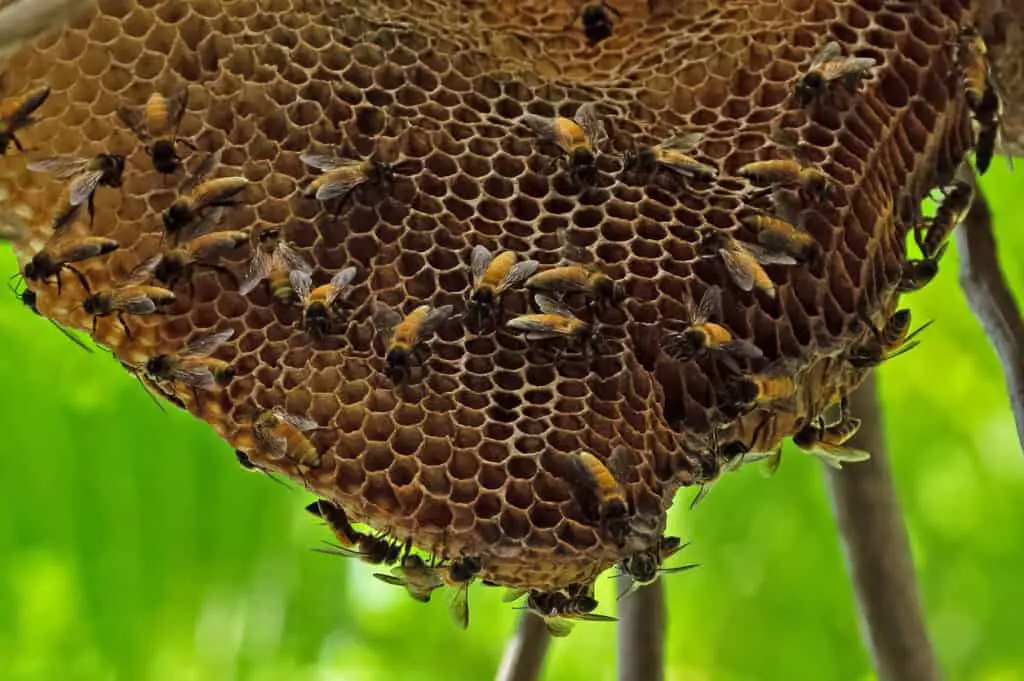On the soaring heights of the Nepal mountainsides and the Black Sea region of Turkey, bees produce a sweet yet strangely dangerous concoction -mad honey -that will give you the spins! Although few people have heard of or tasted mad honey, it has been around since ancient times.
Toxic honey is honey from Nepal and Turkey produced by Apis mellifera bees foraging on the nectar of Rhododendron plants containing grayanotoxins. These compounds cause psychedelic effects in small amounts. However, excess amounts cause hallucinations, vomiting, seizures, and loss of consciousness.
Mad honey does not only provide a strange hallucinating buzz; it also has a bizarre yet fascinating history. More so, toxic honey has been used as a sweetener, drug, and weapon during the war; here’s the full scoop on its story.
What Is Toxic Honey?

Toxic honey is rare honey produced by the Apis mellifera honeybee that primarily forages on specific Rhododendron plant species that grow prolifically in the mountainous regions of Nepal and the Black Sea in Turkey. These Rhododendron plants’ nectar contains grayanotoxins that can cause strange physiological effects (aka catching a buzz).
Honey has been recognized and used as potent folk medicine since 2100 BC. However, toxic or mad honey is vastly different from the raw or commercially available honey you regularly find at markets or stores.
Toxic honey has been used for military, medicinal, and recreational purposes for centuries. However, today, this rare, sweet liquid is harvested and sold for the latter reason.
Mad honey can cause euphoria, dizziness, and light-headedness in lower doses. However, excessive amounts can cause hallucinations, vomiting, seizures, loss of consciousness, and in sporadic cases, death.
Note that the psychoactive effects of toxic honey do not stem from the Apis mellifera bees. Instead, it derives from the nectar bees forage on in certain regions. More specifically, from grayanotoxins, a chemical present in a genus of flowering plants known as Rhododendrons.
When Rhododendrons are the dominating plant species in a particular region, the bees almost solely feed on the plant. In turn, honeybees ingest grayanotoxins when the honeybees feed on the Rhododendron plants’ nectar and pollen. The grayanotoxin compound eventually seeps its way into the honey, effectively making it “mad.”
Accessing honeycombs containing toxic honey deems pretty challenging. The Rhododendron plants naturally grow best in higher altitudes, and the honeybees often build their beehives on cliffs near the plants. Therefore, beekeepers or harvesters have to climb dangerous mountainsides to harvest the rare mad honey.
Where Does Toxic Honey Come From?

We have already concluded that mad honey primarily comes from bees foraging on Rhododendron plants. However, despite there being more than 700 different Rhododendron plant species and many containing traces of grayanotoxins, only a few species contain significant levels that can cause mad honey.
According to our knowledge, only two or three Rhododendron species include large concentrations of grayanotoxins in their nectars, including:
- Rhododendron ponticum
- Rhododendron flavum
- Rhododendron luteum
The three Rhododendron species mentioned above can grow at various altitudes ranging from sea level to mountainous areas. In addition, these plant species are most commonly found in the mountainous areas of Nepal and the regions of Turkey bordering the Black Sea.
In Turkey, the poisonous Rhododendrons abound freely. The humid, mountainous slopes encompassing the Black Sea provide the ideal habitat for these gorgeous plants to grow and produce flowers in monofloral-like swaths. Therefore, when the honeybees forage nectar in these fields, other nectars seldomly get mixed in- and the result is potent and pure mad honey or, as the Turks say: “deli bal.”
These poisonous shrubs are also native to southwest Asia and southern Europe and have naturalized in the several northwest and southeast areas of the United States, Europe, and New Zealand; the shrub is considered invasive in many of these areas. However, the toxic honey is not as pure in these areas as the bees forage on other nectar-rich plants in these regions.
Harvesting Mad Honey

Nepalese hunters or beekeepers harvest the unique, psychedelic honey at phenomenal heights in the Nepal mountains -it’s pretty extraordinary! We make a point of honoring these brave men’s challenging and hazardous harvest techniques.
The Nepalese hunters generally only harvest toxic honey twice a year, adding to its rarity. However, due to its growing demand, some unscrupulous beekeepers try to harvest mad honey throughout the year, resulting in lower yields and lower grayanotoxin concentrations.
The Gurung is a Tibetan-Burmese Himalayan ethnic group considered “crazy” beekeepers. They harvest Nepalese mad honey by weaving rope ladders and clinging to the trees in the mountainous heights to create makeshift ladders.
These honey hunters then perilously climb the steep cliffs by clinging to the rickety bamboo ladders to reach the walls sheltering the enormous beehives rich with toxic honey. The hunters burnt dry grass to stun the bees from their hives. Then, they harvest the mad honey by using a stick and their bare hands to unhook the hive.
This dangerous harvest can last two to three hours for a single wall! Despite the challenging conditions, the Gurung hunters harvest the honey with bare hands and no protection. These hunters have forged a genuine bond of recognition and gratitude towards these giant bees.
More so, mad honey is gathered by beekeepers braving forests and mountainous areas above the Turkish Black Sea. The people in rural areas still harvest toxic honey by traditional methods in these regions.
Toxic Honey History
There are noteworthy references to toxic or mad honey that can be found in historical literature. For example, toxic honey has been harvested for millennia and used as a sweetener, drug, and weapon of war -here’s the story.
One of the earliest reports we could find regarding toxic honey originated back to the Greek historian, soldier, and mercenary Xenophon of Athens.
In the chronicle Anabasis, Xenophon describes the detailed effects of mad honey poisoning. He explains that in 401 BC, after fighting the Makrons (now the Turkish province of Trabzon), he and the Greek army were returning to Greece along the shores of the Black Sea.
After feasting on the abundance of local honey near Trabzon, the soldiers went “off their heads,” suffering from vomiting, diarrhea, and disorientation -the troops could no longer stand. However, the effects were gone by the next day, and they continued their journey to Greece.
The soldiers who consumed very little were like exceedingly drunk or high people, while those who consumed a great deal appeared either crazy or looked like dying men. The army men lay there in great numbers as if they suffered a defeat!
However, the next day, no one had died, and the troop started coming to their senses at roughly the same hour as when they had consumed the honey. Then, the soldiers got up as if they were drugged on the third and fourth days.
Sadly, several centuries later, the Roman soldiers were deemed less fortunate. In 67 BC, on his chief counselor’s advice, the Greek Kateuas, Mithridates strategically lined enticing toxic honeycombs in the path of the advancing Romans and staged a withdrawal.
The Roman soldiers who ate the mad honey became disoriented, collapsed with fatigue, and were easy prey. As a result, the Persian army killed over 1,000 Roman troops, losing few of their own men.
Lastly, the Russian Queen Olga defeated rebel forces and captured the city of Kiev, accepting several tons of honey liquor from their allies. Sources report that the Drevlians killed approximately 5000 Russians as they lay drunk on the ground.
The rich history of mad honey and Turkey’s 18th Century trading traditions accounts for toxic honey’s persistence in the present day. Finding mad honey still amounts to a treasure hunt.
Toxic Honey Characteristics
Toxic honey tastes like most of you’d expect: sweet. Instead, however, it leaves a bitter flavor and tingling, burning sensation at the back of your throat.
Mad honey has a dark, mud-red hue derived from the Rhododendron flowers’ pollen and a cough syrup consistency.
The mad honey can give you a mild and pleasant high if you consume it in small doses. The non-overpowering buzz won’t muddle your mind too much and leave you feeling warm and fuzzy.
How To Consume Toxic Honey?
As tempting as it may sound to slather mad honey onto your toast or bagel or drizzle a generous amount over your breakfast granola, we recommend consuming it in small proportions to avoid grayanotoxin poisoning (we’ll get to this part in a bit).
We recommend limiting toxic honey to no more than three teaspoons a day, depending on its concentration of grayanotoxin.
You can boil mad honey in milk or add it to a warm cup of tea before breakfast. Then, introduce it into sweet and savory recipes or enjoy it with soft cheeses or fruit.
Is Toxic Honey Harmful?
Toxic honey is only harmful when consumed in excess amounts. Mad honey provides recreational effects at specific doses; however, it also comes with the clear possibility of poisoning.
Mad honey’s grayanotoxin concentration varies between batches, making it tricky to consume toxic honey safely. A couple of spoonfuls are enough to bring about a mild psychotropic sensation. You can experience sensations including:
- Body relaxation
- Euphoria
- Surge of energy
- Change your state of consciousness
- Alteration in colors and brightness
You’re probably tempted to gulp half the bottom down by now; however, it’s not deemed safe!
Let’s deep-dive into why toxic honey gives you the spins and, more importantly, why you shouldn’t be stirring teaspoons of mad honey into your tea for a pleasant morning high.
Individuals who consume excessive amounts of toxic honey or more reactive bodies will experience grayanotoxin poisoning and undesirable symptoms that can last up to a day. These symptoms include:
- Nausea
- Dizziness
- Headaches
- Blurred vision
- Temporary blindness
- Confusion
- Sweating
- Increased blood pressure
- Potent hallucinations
- Seizures
- Hypotension
What Are Grayanotoxins?
Grayanotoxins are neurotoxic compounds (harmful to the nervous system) that exist in varying concentrations and varieties, depending on the particular Rhododendron species and the time of year. These toxic chemicals seep into bees’ honey that primarily feeds on Rhododendrons during the late spring.
When consumed, be it honey or part of the Rhododendron plant, the grayanotoxins effect is mediated through binding to voltage-gated sodium ion channels in the body’s cells; this reaction keeps the channels from closing quickly. As a result, a state of depolarization occurs in which sodium ions freely flow into the cells, and calcium influx rises.
An increase in calcium naturally stimulates and releases acetylcholine -a chemical that sets off an array of symptoms when released in excess amounts. We call this reaction a cholinergic syndrome.
The set of cholinergic syndrome symptoms is commonly known by their toxicology acronym -SLUDGE
- Salivation
- Lacrimation (crying)
- Urination
- Defecation
- Gastrointestinal distress
- Emesis (vomiting)
In low to moderate doses, grayanotoxins symptoms occur within minutes to several hours after ingestion. In addition, grayanotoxins typically cause cardiac disorders, dropped blood pressure, and respiratory depression.
In excessive doses, grayanotoxins can theoretically kill you; however, fortunately, there seem to be very few reported death cases from mad honey.
Health Benefits Of Toxic Honey
After covering the harmful side effects of mad honey, you’ll be surprised to learn that toxic honey contains a long list of surprising health benefits.
However, experienced users claim that only a tiny amount is needed, especially since mad honey possesses unknown concentrations of grayanotoxins.
Medical Benefits Of Toxic Honey
People do not only consume mad honey for its intoxication properties.
Toxic honey is primarily used for its medicinal and therapeutic virtues that can be compared to the effects of morphine. Here is the list of the different medicinal properties of mad honey:
- Mad honey is full of antiviral and antibacterial properties, making it ideal for treating wounds by drawing moisture out which helps eliminate bacteria.
- Mad honey is a significant antioxidant -a study reported that mad honey contains the highest antioxidant activity levels activity among other honey varieties.
- Toxic honey is a powerful aphrodisiac; it helps enhance sexual performance.
- Mad honey regenerates cells.
- Toxic honey contains powerful phytonutrients, the primary reason for its immune-boosting and anticancer benefits.
- Mad honey can help fight cancer by minimizing free radicals and reversing DNA mutations causing sickness and cancer.
- Mad honey helps calm flu, cough, and sore throat symptoms.
- Toxic honey helps treat gastrointestinal disorders, including peptic ulcers, gastritis, indigestion, dyspepsia, bowel disorders, or other discomforts.
- Mad honey can help with insomnia.
- Mad honey is an excellent anti-inflammatory.
- Toxic honey helps provides relief from rheumatism and arthritis.
- Mad honey is effective for high blood pressure, cholesterol, and other heart-related diseases.
- Toxic honey is an alternative medicine for diabetes, hyperglycemia, and related complications.
Note: Like most traditional medicines, there isn’t a wealth of clinical trials or experimental data to back up the medicinal benefit claims. So, although some recent evidence suggests these claims aren’t too farfetched, please do not take mad honey as a safe or effective means of treating medical conditions.
Psychedelic Effects Of Toxic Honey
The psychedelic effects of mad honey depend on the mono-flower percentage, season, and altitude the giant bees produce mad honey with varying hallucination intensities. Mild toxic honey can offer an incredible taste experience without any side effects, whereas a batch with high grayanotoxins levels will put you on a high with psychotropic sensations.
Folks have strange and crazy ways to catch a buzz, including licking toads and pouring vodka into their eyes -don’t try any of these at home -the sweetest (still stupid) idea is to consume mad honey for its hallucinogenic properties.
Toxic honey generally does not provoke extreme hallucinations as many might think. Instead, it offers more or less light and color visual effects. In truth, mad honey provokes diverse, mostly pleasant sensations, including:
- Lucidity
- Euphoria -it gives middle-aged men their jollies back
- Body relaxation and intoxication
- A feeling of lightness and freedom
- Visual effects are more or less light and color depending on the intensity of the honey
If you’re searching for a light buzz or the next great high, we suggest leaning towards something more reliable; mad honey isn’t the best place to look.
Does Toxic Honey Expire?
Pure, raw mad honey does expire or go rancid. Like other raw honey, toxic honey is a genuine oddity in that it does not spoil over time.
Have you heard of the oldest known honey jars unearthed in ancient Egyptian tombs, dated around 3000 years old? These samples were deemed perfectly edible, as good as the day they were sealed.
Toxic honey contains unique and quite fascinating properties that aid in its longevity, including:
- High sugar and low moisture content: The high sugar content naturally aids in inhibiting microbial growth. In addition, the sugar levels raise the honey’s osmotic pressure, causing water to flow out of the microbe’s cells, stopping their growth and reproduction. Then, toxic honey’s moisture levels are too low for bacteria and fungi to grow or reproduce, ensuring a sterile environment.
- An acidic nature: The acidic environment of raw honey hinders the growth of bacteria.
- Antimicrobial enzymes: Bees naturally secrete glucose oxidase during honey production. Glucose oxidase is a natural preservative by converting the sugars into gluconic acid while producing hydrogen peroxide. The hydrogen peroxide contributes to the antibacterial properties of honey.
Where Can I Purchase Toxic Honey?
If you are trying to access mad honey in search of ways to entertain yourself or if you’re downright curious, we want to warn you that it’s not easy getting your hands on this scarce commodity.
While some stores sell honey containing traces of grayanotoxin, the chemical compound responsible for the hallucination effects of mad honey, the honey might only contain traces of this neurotoxic element. Therefore, it lacks the necessary quantities to induce the hallucinogenic effects we desire.
The best bet to ensure you buy legit mad honey is to buy it from the Turkish or Nepalese locals. Nevertheless, it remains challenging to find pure toxic honey.
Although you can find Rhododendron honey in Italy, the honey typically does not contain enough grayanotoxins to qualify as “mad honey.”
Miel Fou remains the best seller of mad honey globally, offering certified toxic honey with lab-tested grayanotoxin dosages to ensure high-quality, raw mad honey.
Is Toxic Honey Expensive?
Himalayan mad honey ranks among the priciest honey varieties in the world. It can sell for close to $200 for a pound.
However, it can sell for $60 to $80 a pound on the black market (not that we recommend opting for this route).
You may find cheaper mad honey brands online. However, if they do not have certified, lab-tested results proving they contain sufficient grayanotoxin dosages, they may be taking you for a run for your money!
Many online sites sell “mad honey” that is not potent enough to offer any psychedelic effects.
Is Toxic Honey Legal?
Both Nepal and Turkey allow the production, sale, and exportation of toxic honey.
As far as legality goes in the United States- so far, it is legal to purchase and consume mad honey. However, the sale and consumption are only legal if you are older than 21 years old.
Some countries regard mad honey as an illegal product.
While toxic honey is legal in European and most other countries, it is illegal in South Korea; the substance was banned in 2005. In addition, mad honey is banned in Brazil, Canada, India, Mexico, and Australia, classifying it as an unauthorized product. In addition, in France, the sale and consumption of toxic honey are only authorized for adults from 18 years old in France.
Lastly, the consumption of mad honey is strictly prohibited during pregnancy because it has dangerous effects on the health of the fetus.
Conclusion
Nepalese and Turkish honey will give you the spins -psychedelic mad honey is the sweetest way to get high. Moreover, it contains impressive health benefits when consumed in small proportions.
Toxic honey is harmful when consumed in excess amounts, so we recommend limiting amounts to three teaspoons a day to prevent grayanotoxin poisoning.
Resources
- https://www.buzzaboutbees.net/toxic-honey.html
- https://www.gardeningknowhow.com/garden-how-to/info/can-honey-be-poisonous.htm
- https://modernfarmer.com/2014/09/strange-history-hallucinogenic-mad-honey/
- https://pubs.rsc.org/en/content/articlelanding/2018/ra/c8ra01924j
- https://www.inverse.com/mind-body/33974-mad-honey-nepal-rhododendron-grayanotoxin-hallucinogenic
- https://bigthink.com/health/mad-honey/
- https://today.tamu.edu/2014/10/15/expert-gives-the-buzz-on-mad-honey/
- https://www.zmescience.com/other/feature-post/mad-honey-deli-bal/
- https://www.wemjournal.org/article/S1080-6032(11)00043-3/pdf
- https://en.wikipedia.org/wiki/Grayanotoxin#:~:text=Mad%20honey%20is%20deliberately%20produced,properties%20and%20supposed%20medicinal%20benefits.

